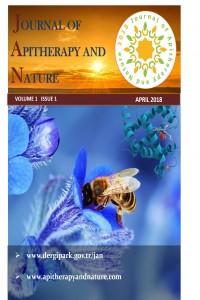Abstract
There are applied
chemical substances against the helminthes which parasitize in sheep. These
massively applied ant-helminthes are excreted from the organism late along with
exerting an influence of 1 direction on the organism of an animal that it
sometimes has a cumulative effect on them. We investigated the antihelminthic
effect of the plants (clover, absinth) which influence animals in a complex
way, are excreted from the organism soon and spread widely in Autonomous
Republic. Trifolium pretense L. which
we use in our experiences and constitutes the basis of fodder of animals, is
perennial herbs-with three leaves and its blossoms are collected in the head
blossom group. Artemisia absinthum is mainly used in the treatment of
cestodoses by being known as antihelminthic plant since ancient times. ln our
research work we investigated the antihelminthic effects and economic
efficiencies of clover and absinth in the condition of in vitro and in vivo, at
the same time, by grazing the animals which were naturally infected with the
helminthes, in the area with the same plants. Plants thoroughly set animals
free from parasites by having antihelminthic effect in the high level in the
form of separate and together grazing.
References
- Adilov, T. A. (1970). Harmful and alkaloid plants of Uzbekistan, Tashkent. Antihelmint-antihelmint medicine, (82-124).
- Aliyev, N., Guliyev, K. H., & Ibragimov, G. (1971). Antimicrobe influence of the ether oils of some plants. Heraclum. J from Azerbaijan/Plant resource/LT.YII, 1, 85-88.
- Berezekina, S. V., & Demidov, N. V. (1979). Antihelmint properties of some plants. Bulletin VIGIS, 2, 8-11.
- Damir, I. A., Prilipko, L. I., Shukurov, D. E., & Kerimov, Y. B. (1988). The medicine plants of Azerbaijan (pp. 304). Baku: Maariph.
- Eminov, R. Sh. (1982). Episotoology of the trikhostrongylesia and osteratagiose of the sheep in the regions of the south foothills of Big Caucasus of Azerbaijan SSR and efficiency of some medicine plants during the invasions (Master thesis). Available from Candidate of Veterinary Science.
- Hajiyev, Y. G., & Eminov. R. Sh. (1986). The influence of the medical plants to the method of the stomach-intestine tracts of the sheep. Bulletin VIGIS, 44, 12-16.
- Hajiyev, Y. G., & Maharramov, S. H. (1996). The antihelmint efficiency of Peganium harmala. Azerbaijan Agrarian Science, 1(2), 65-66.
- Hajiyev, Y. G. (2000). The evaluation of the economical efficiency in Helmintose. Azerbaijan Agrarian Science, 1(2), 66-70.
- Maharramov, S. G. (2000). The antihelmint efficiency against stomach-intestine tract of the sheep. Agrarian Science of Azerbaijan, 1(2), 70-80.
- Maharramov, S. H. (2001). Antihelmint medicine plants of Nakhchevan AR, The Autonomic Republic of Nakhchevan, Natural resources and the ways of the efficient use (pp. 56-57). Nakhchevan, Geyrat.
- Maharramov, S. G. (2002). The evaluation of economy efficiency against worms in Farmer Economies. The development problems of the entrepreneurship and small-scale business (pp. 42-44).
- Mammadov, A. G., Hajiyev, Y. H., Shirinov, N. M., & Agayev, A. A. (1986). Veterinary-parasitology (pp 428). Baku: Azerneshr.
- Maharramov, S. H. (2008). The embrotype influence against of Chashir-Ajligotu mixture, Azerbaijan Zoologists Society, Science works, 1, 127-129.
- Ozguven, M., & Tansı, S. (1999). Mercanköşk (Majorana hortensis Moench)'de gelişme dönemlerine göre verim ve kalite. Turkish Journal of Agriculture and Forestry, 23(1): 11-17.
- Rabinovich, M. I., (1988). Veterinary phytotheraphy (p. 166). Moscow, Russia: Agroindustry Publishing.
- Sokolov, S. Y., & Zamotayev, I. P. (1984). The report book of the medicine plants (pp. 86-88). Moscow, Russia: Medicina.
Abstract
References
- Adilov, T. A. (1970). Harmful and alkaloid plants of Uzbekistan, Tashkent. Antihelmint-antihelmint medicine, (82-124).
- Aliyev, N., Guliyev, K. H., & Ibragimov, G. (1971). Antimicrobe influence of the ether oils of some plants. Heraclum. J from Azerbaijan/Plant resource/LT.YII, 1, 85-88.
- Berezekina, S. V., & Demidov, N. V. (1979). Antihelmint properties of some plants. Bulletin VIGIS, 2, 8-11.
- Damir, I. A., Prilipko, L. I., Shukurov, D. E., & Kerimov, Y. B. (1988). The medicine plants of Azerbaijan (pp. 304). Baku: Maariph.
- Eminov, R. Sh. (1982). Episotoology of the trikhostrongylesia and osteratagiose of the sheep in the regions of the south foothills of Big Caucasus of Azerbaijan SSR and efficiency of some medicine plants during the invasions (Master thesis). Available from Candidate of Veterinary Science.
- Hajiyev, Y. G., & Eminov. R. Sh. (1986). The influence of the medical plants to the method of the stomach-intestine tracts of the sheep. Bulletin VIGIS, 44, 12-16.
- Hajiyev, Y. G., & Maharramov, S. H. (1996). The antihelmint efficiency of Peganium harmala. Azerbaijan Agrarian Science, 1(2), 65-66.
- Hajiyev, Y. G. (2000). The evaluation of the economical efficiency in Helmintose. Azerbaijan Agrarian Science, 1(2), 66-70.
- Maharramov, S. G. (2000). The antihelmint efficiency against stomach-intestine tract of the sheep. Agrarian Science of Azerbaijan, 1(2), 70-80.
- Maharramov, S. H. (2001). Antihelmint medicine plants of Nakhchevan AR, The Autonomic Republic of Nakhchevan, Natural resources and the ways of the efficient use (pp. 56-57). Nakhchevan, Geyrat.
- Maharramov, S. G. (2002). The evaluation of economy efficiency against worms in Farmer Economies. The development problems of the entrepreneurship and small-scale business (pp. 42-44).
- Mammadov, A. G., Hajiyev, Y. H., Shirinov, N. M., & Agayev, A. A. (1986). Veterinary-parasitology (pp 428). Baku: Azerneshr.
- Maharramov, S. H. (2008). The embrotype influence against of Chashir-Ajligotu mixture, Azerbaijan Zoologists Society, Science works, 1, 127-129.
- Ozguven, M., & Tansı, S. (1999). Mercanköşk (Majorana hortensis Moench)'de gelişme dönemlerine göre verim ve kalite. Turkish Journal of Agriculture and Forestry, 23(1): 11-17.
- Rabinovich, M. I., (1988). Veterinary phytotheraphy (p. 166). Moscow, Russia: Agroindustry Publishing.
- Sokolov, S. Y., & Zamotayev, I. P. (1984). The report book of the medicine plants (pp. 86-88). Moscow, Russia: Medicina.
Details
| Primary Language | English |
|---|---|
| Journal Section | Research Articles |
| Authors | |
| Publication Date | April 1, 2018 |
| Published in Issue | Year 2018 Volume: 1 Issue: 1 |
Cite
- Google Akademik (Google Scholar)
- idealonline
- Directory of Research Journal Indexing (DRJI)
- Asos İndeks

